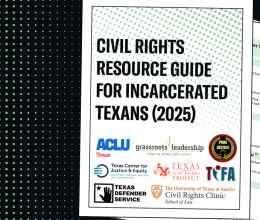
Victoria Hirschberg: The Monitor
EDINBURG - A bus from the Texas Department of Criminal Justice is scheduled to arrive every Wednesday morning at the Hidalgo County Jail to transfer inmates to state prisons.
Once an inmate is "paper-ready" - the file is completed, sent to the state and approved there - Texas law requires state criminal justice officials to pick up that inmate within 45 days.
But it's not so simple.
In some cases, 45 days have turned into months, and as inmates sit in county jail, exacerbating an already overcrowded system, local taxpayers are picking up the tab.
Right now, there are 37 inmates who remain in the Hidalgo County Adult Detention Center past their 45 days. More than 200 inmates are "paper-ready," but might not be ready for transfer into the state system. Many inmates face multiple charges and remain in Hidalgo County until their court date. Sometimes, little details like a missing signature in the packet or a mail delay can halt the process.
"You have the law enforcement, the corrections system and the court system, and any increase in any one of those areas is going to have a direct impact on the other areas," said Dr. Philip Etheridge, criminal justice professor at the University of Texas-Pan American. "Therefore, if you have more inmates, more arrests being made, you're going to have more people go through the court system and going to be in the jail system."
And as fast as Hidalgo County is growing, the problem is not going away any time soon.
Earlier this year, many expected the jail's population to decrease after Labor Day; however, the exact opposite happened.
Since the first week of September, the county has been responsible for more than 1,300 inmates. That's 100 inmates more than the county's jail can hold under the best of circumstances, but the facility north of Edinburg can't hold every inmate because inmates are separated based on health, gang affiliations and crime severity.
So far, Hidalgo County has spent almost $800,000 to send its overflow of inmates to detention centers in Brooks and Frio counties and a private facility in La Villa. Each facility charges almost $40 per inmate each day.
County budget analyst Raul Silguero said by the end of 2005, the county could easily expend $1.5 million for out-of-county inmates.
Local officials don't seem to know what to do.
Should the county build another jail less than five years after it poured millions into the new facility? Should it pressure the state to pick up inmates more quickly? Should it seek other counties to contract with to house its inmates?
"The county has to house the prisoners out of county until the state picks them up, and (the county has to) pay the price," said Precinct 4 Commissioner Oscar Garza. "There's no other way around it. We specifically have been tracking these numbers because we need to know, OK, do we need to build another pod or two, continue renting outside or get the state to pick up these guys? I don't know if there's a clear cut answer."
Texas Criminal Justice Department spokesman Mike Viesca said the state is moving as efficiently as possible, given the recent hold-ups Hurricane Rita has caused. For about two weeks, the state halted transfers because prisoners from facilities in the Beaumont area had to be temporarily relocated, filling up beds throughout Texas. Transfers are now slowly resuming.
On average, Viesca said it takes about 25 days to process and transfer an inmate into the state prison system, which is at 96-percent capacity. That's not fast enough, Garza said.
Dealing with jail overcrowding is not a new issue. In 1972, several Texas prison inmates filed a lawsuit against the Texas Department of Corrections. After a judge ruled in favor of the inmates and found the department in violation of the Eighth Amendment, which prohibits cruel and unusual punishment, TDC spent millions on constructing new prisons to avoid overcrowding.
"The prisoners, as far as transport and timelines, were not an issue because they built all these prisons," Garza said about the case. "Then with the (budget) shortfall the state has been going through coupled with growth and the population explosion you have two issues working directly against each other."
Sometimes it's not always the state, though. The county can also hold up the process.
Before an inmate is "paper-ready," several entities need to complete the inmate's packet for the state. The packet includes the judge's orders and signatures, approval from the district attorney, the offense report from the department that arrested the individual and the indictment, said Jail Commander Daniel Garcia.
"Often something is missing," Garcia said of the information packets. "We're not perfect."
The state does not start counting the 45 days until the packet is perfect.
Also, prisoners may be "paper-ready," but some may have charges pending in other cases, which keeps them in the county jail.
To save money, Garcia said he'd prefer sending inmates with multiple charges to state facilities and bringing them back for court in Hidalgo County.
"I'd rather spend $80 for gas to go get them than $40 a day to keep them here," he said.
County officials already budgeted about $1.5 million to house out-of-county inmates in 2006. If the out-of-county population continues to increase or stays consistent, Hidalgo County could end up paying almost $300,000 a month in that year, which would exceed the budgeted amount.
"Any delay in moving an inmate costs this county money," said Etheridge of UTPA. "Whether it's one day or 50, this is a problem every county faces, and it doesn't go away."






